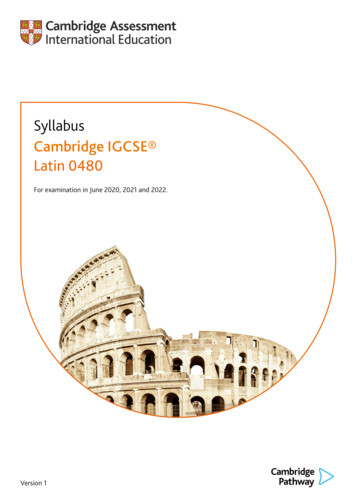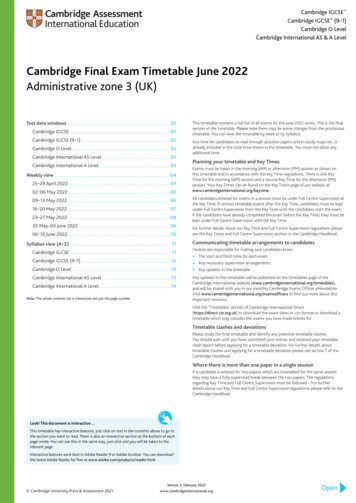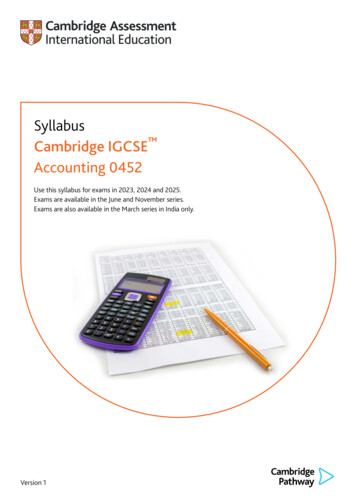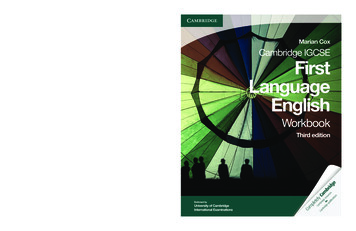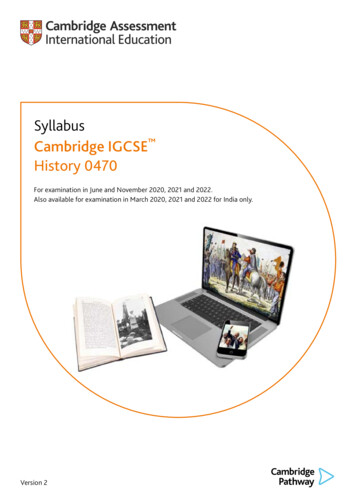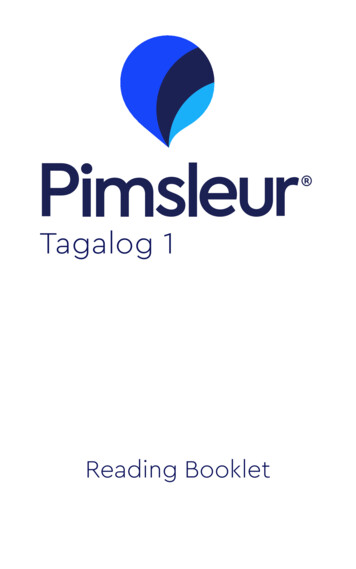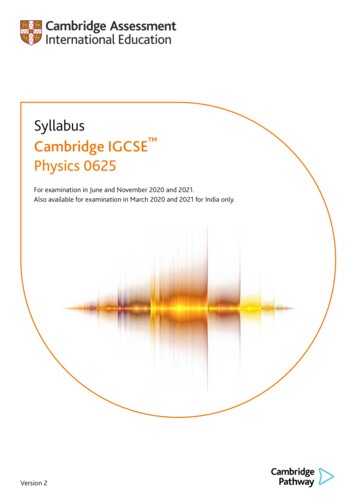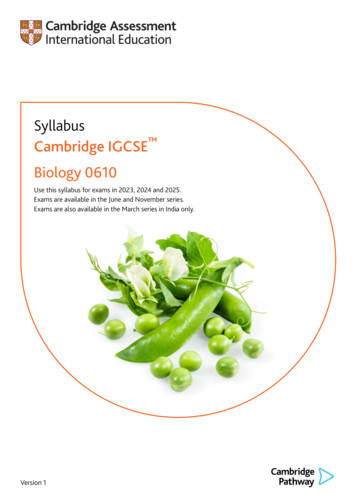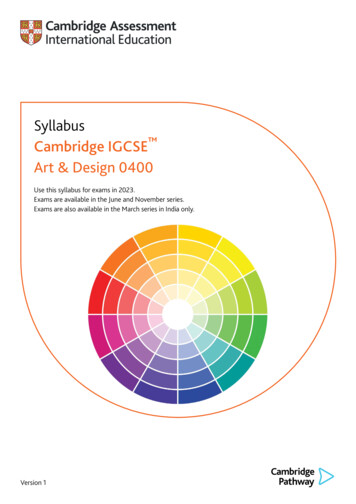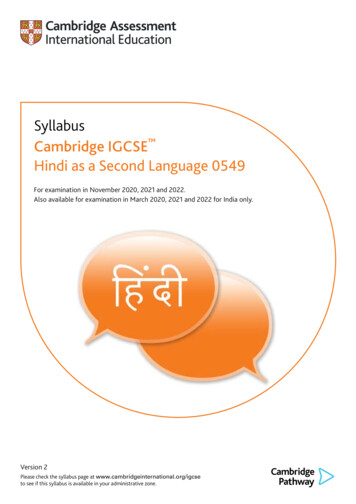
Transcription
SyllabusCambridge IGCSE Hindi as a Second Language 0549For examination in November 2020, 2021 and 2022.Also available for examination in March 2020, 2021 and 2022 for India only.Version 2Please check the syllabus page at www.cambridgeinternational.org/igcseto see if this syllabus is available in your administrative zone.
Why choose Cambridge?Cambridge Assessment International Education prepares school students for life, helping themdevelop an informed curiosity and a lasting passion for learning. We are part of the University ofCambridge.Our international qualifications are recognised by the world’s best universities and employers, givingstudents a wide range of options in their education and career. As a not-for-profit organisation, wedevote our resources to delivering high-quality educational programmes that can unlock learners’potential.Our programmes and qualifications set the global standard for international education. They are createdby subject experts, rooted in academic rigour and reflect the latest educational research. They providea strong platform for learners to progress from one stage to the next, and are well supported byteaching and learning resources.Our mission is to provide educational benefit through provision of international programmes andqualifications for school education and to be the world leader in this field. Together with schools,we develop Cambridge learners who are confident, responsible, reflective, innovative and engaged –equipped for success in the modern world.Every year, nearly a million Cambridge students from 10 000 schools in 160 countries prepare for theirfuture with an international education from Cambridge International.‘We think the Cambridge curriculum is superb preparation for university.’Christoph Guttentag, Dean of Undergraduate Admissions, Duke University, USAQuality managementOur systems for managing the provision of international qualifications and education programmesfor students aged 5 to 19 are certified as meeting the internationally recognised standard forquality management, ISO 9001:2008. Learn more at www.cambridgeinternational.org/ISO9001Cambridge Assessment International Education is part of the Cambridge Assessment Group. Cambridge Assessmentis the brand name of the University of Cambridge Local Examinations Syndicate (UCLES), which itself is a departmentof the University of Cambridge.UCLES retains the copyright on all its publications. Registered centres are permitted to copy material from thisbooklet for their own internal use. However, we cannot give permission to centres to photocopy any material that isacknowledged to a third party even for internal use within a centre.
Contents1 Why choose this syllabus? . 2Key benefits2Recognition and progression3Supporting teachers42 Syllabus overview . 5Aims5Content overview5Assessment overview63 Subject content . 74 Details of the assessment . 9Paper 1 – Reading and Writing9Paper 2 – Listening10Component 3 – Speaking (optional)11Speaking assessment criteria grid145 Assessment objectives . 186 What else you need to know . 20Before you start20Making entries21After the exam22Grade descriptions22Changes to this syllabus for 2020, 2021 and 202223Changes to this syllabusThe latest syllabus is version 2, published February 2019.For information about changes in this syllabus for 2020, 2021 and 2022, go to page 23.
Cambridge IGCSE Hindi as a Second Language 0549 syllabus for 2020, 2021 and 2022.1 Why choose this syllabus?Key benefitsCambridge IGCSE syllabuses are created especially for international students. For over 25 years, wehave worked with schools and teachers worldwide to develop syllabuses that are suitable for differentcountries, different types of schools and for learners with a wide range of abilities.Cambridge IGCSE Hindi as a Second Language is accepted by universities and employers as proof ofknowledge and understanding of Hindi as a Second Language.The Cambridge IGCSE Hindi as a Second Language syllabus encourages learners to developan understanding of a wide range of social registers and styles, and to learn to communicateappropriately.Our programmes balance a thorough knowledge and understanding of a subject and help to developthe skills learners need for their next steps in education or employment.Our approach encourages learners to be:Cambridgelearner‘The strength of Cambridge IGCSE qualifications is internationally recognisedand has provided an international pathway for our students to continue theirstudies around the world.’Gary Tan, Head of Schools and CEO, Raffles International Group of Schools, Indonesia2www.cambridgeinternational.org/igcseBack to contents page
Cambridge IGCSE Hindi as a Second Language 0549 syllabus for 2020, 2021 and 2022. Why choose this syllabus?Recognition and progressionThe combination of knowledge and skills in Cambridge IGCSE Hindi as a Second Language giveslearners a solid foundation for further study. Candidates who achieve grades A* to C are wellprepared to follow a wide range of courses including Cambridge International AS & A Level Hindi, orthe equivalent.Cambridge IGCSEs are accepted and valued by leading universities and employers around theworld as evidence of academic achievement. Many universities require a combination of CambridgeInternational AS & A Levels and Cambridge IGCSEs to meet their entry requirements.UK NARIC, the national agency in the UK for the recognition and comparison of internationalqualifications and skills, has carried out an independent benchmarking study of Cambridge IGCSE andfound it to be comparable to the standard of GCSE in the UK. This means students can be confidentthat their Cambridge IGCSE qualifications are accepted as equivalent to UK GCSEs by leadinguniversities worldwide.Learn more at idge IGCSE is one of the most sought-after and recognisedqualifications in the world. It is very popular in Egypt because it provides theperfect preparation for success at advanced level programmes.’Mrs Omnia Kassabgy, Managing Director of British School in Egypt BSEBack to contents pagewww.cambridgeinternational.org/igcse3
Cambridge IGCSE Hindi as a Second Language 0549 syllabus for 2020, 2021 and 2022. Why choose this syllabus?Supporting teachersWe provide a wide range of practical resources, detailed guidance, and innovative training andprofessional development so that you can give your learners the best possible preparation forCambridge IGCSE.Teaching resourcesExam preparation resources School Support Hubwww.cambridgeinternational.org/support Question papers Syllabus Scheme of work Example candidate responses to understandwhat examiners are looking for at key grades Learner guide Examiner reports to improve future teaching Mark schemes Discussion forum Resource list Endorsed textbooks and digitalresourcesTraining Face-to-face workshops around theworld Online self-study training Online tutor-led training Cambridge Professional al.org/igcseSupport forCambridgeIGCSECommunityYou can find useful information, as well asshare your ideas and experiences with otherteachers, on our social media channels andcommunity forums.Find out more atwww.cambridgeinternational.org/social-mediaBack to contents page
Cambridge IGCSE Hindi as a Second Language 0549 syllabus for 2020, 2021 and 2022.2 Syllabus overviewAimsThe syllabus aims summarise the context in which you should view the syllabus content and describethe purposes of a course based on this syllabus. They are not listed in order of priority.The aims are to: develop the ability to use Hindi effectively for the purpose of practical communication form a sound base for the skills required for further study or employment using Hindi as themedium develop an awareness of the nature of language and language-learning skills encourage learners’ use of the expanding body of new vocabulary in Hindi promote learners’ personal development.Content overviewCambridge IGCSE Hindi as a Second Language offers learners the opportunity to develop practicalcommunication skills in listening, speaking, reading and writing. In both written and spoken Hindi,learners will be able to follow factual information as well as abstract ideas, select relevant details, andunderstand what is directly stated or implied.Learners will be encouraged to respond effectively to a variety of stimuli. They will be able to expresstheir viewpoints with a degree of accuracy and clarity, in spoken and written form, in order to meetthe needs of the given purpose and target audience. This will enable learners to become independentusers of Hindi in a range of contexts.Support for Cambridge IGCSE Hindi as a Second LanguageOur School Support Hub www.cambridgeinternational.org/support provides Cambridgeschools with a secure site for downloading specimen and past question papers, mark schemes,grade thresholds and other curriculum resources specific to this syllabus. The School SupportHub community offers teachers the opportunity to connect with each other and to ask questionsrelated to the syllabus.Back to contents pagewww.cambridgeinternational.org/igcse5
Cambridge IGCSE Hindi as a Second Language 0549 syllabus for 2020, 2021 and 2022. Syllabus overviewAssessment overviewAll candidates take two components.Centres can choose to enter candidates for an optional third component: Component 3 Speaking.Component 3 is internally marked and externally moderated.Marks for Component 3 do not contribute to the overall qualification grade: this component isseparately endorsed. Where candidates perform to an appropriate standard, certificates recordseparately a grade from 1 (high) to 5 (low) for Speaking.All candidates take:Paper 1Reading and Writingand:2 hours67%Paper 2ListeningApprox. 35–45 minutes33%60 marks30 marksWritten examination consisting of sixexercises that test a range of readingand writing skills. Types of task include:short answer questions, multiplematching, note-making, summarywriting, functional writing and extendedwritingWritten examination consisting offour exercises that test listening skills.Candidates listen to recordings of shortand longer spoken texts. Types of taskinclude: short answer questions, gap-fillsentences, information correction andmultiple-choice questionsExternally assessedExternally assessedand candidates can choose to take:Component 3SpeakingApprox. 10–12 minutesSeparately endorsed60 marksThe speaking test consists of threeparts: candidates give a two- to threeminute presentation, followed by a shortdiscussion with the examiner aboutthe presentation, followed by a shortconversation with the examiner aboutgeneral topicsInternally assessed/externally moderated6www.cambridgeinternational.org/igcseBack to contents page
Cambridge IGCSE Hindi as a Second Language 0549 syllabus for 2020, 2021 and 2022.3 Subject contentThe skills covered in the syllabus are outlined below.1Reading understand public notices and signs (including timetables and advertisements) identify and select correct details from simple texts select and organise relevant information from a range of texts that are likely to be withinthe experience of young people and reflecting the interests of people from varied culturalbackgrounds, such as blogs, brochures, emails, forms, imaginative writing, letters, magazines,newspapers and webpages identify some ideas, opinions and attitudes in a range of texts understand what is implied but not directly stated within a text, such as gist, opinion, writer’spurpose and intention identify the important points or themes within an extended piece of writing draw conclusions from an extended text and recognise connections between related ideaswithin a text2Writing communicate factual information, ideas and arguments in short and extended writing tasks inappropriate and accurate Hindi respond to a written stimulus and use appropriate register and style/format for the givenpurpose and audience, such as a summary, an informal letter/email, an article, a report orreview use a range of grammatical structures, punctuation and vocabulary express opinions and use appropriate register/style select and organise information and ideas into coherent paragraphs and use a range of linkingdevices3Listening understand factual information and ideas from a range of sources, such as a recorded phonemessage, news or weather report, travel broadcast, interview, dialogue, memoir or telephoneconversation identify relevant information and select correct details from a range of sources identify ideas, opinions and attitudes from a range of sources and understand the connectionsbetween them show some awareness of what is implied but not directly stated, such as gist, purpose andintentionBack to contents pagewww.cambridgeinternational.org/igcse7
Cambridge IGCSE Hindi as a Second Language 0549 syllabus for 2020, 2021 and 2022. Subject content84Speaking (optional) communicate factual information, ideas and arguments use a range of appropriate vocabulary and grammatical structures using suitable pronunciationand intonation organise and link ideas with a range of appropriate linking devices give a short, clear presentation without a script on a chosen topic demonstrate competence in a range of speech activities, such as respond to questions ontopics within a defined range (for example, past and present schooling, future plans and currentaffairs) take part in a conversation and demonstrate flexibility in dealing with new ideas and otherspeakers’ responses show a sense of audiencewww.cambridgeinternational.org/igcseBack to contents page
Cambridge IGCSE Hindi as a Second Language 0549 syllabus for 2020, 2021 and 2022.4 Details of the assessmentFor information on Assessment objectives (AOs), see Section 5.Paper 1 – Reading and WritingAll questions and responses will be in Hindi.Written paper, 2 hours, 60 marksCandidates should attempt all questions.For all parts of this paper, candidates write their answers in spaces provided in a question paperbooklet. Dictionaries may not be used in the examination.The question paper is divided into six exercises, as follows:Exercise 1 – Short answer questions: candidates read a short text printed in the question paper andanswer a series of questions that test their skimming and gist-reading skills and require short answersof a single word or phrase. The text will be one of the following types: advertisement, brochure,leaflet, guide, report, manual, instructions, newspaper/magazine article.Assessment objectives: R1, R2, R3, R4Total marks: 8Exercise 2 – Multiple matching: candidates read a series of short paragraphs followed by a series ofsentences, then match each sentence to one of the paragraphs.Assessment objectives: R1, R2, R3Total marks: 9Exercise 3 – Note-making: candidates read a longer text printed in the question paper and make briefnotes under a number of supplied headings.Assessment objectives: R1, R2, R3, R4Total marks: 9Exercise 4 – Summary: candidates write a paragraph-length summary (of no more than 100 words)about an aspect or aspects of the text in exercise 3. Candidates should use their own words as far aspossible.Assessment objectives: R2, R3, W1, W2, W3, W4, W5Total marks: 10Exercise 5 – Writing exercise: candidates write a short piece of functional prose such as an email, ofapproximately 120 words. A stimulus of short prompts and/or pictures will be printed in the questionpaper. A purpose, format and audience for the writing will be specified.Assessment objectives: W1, W2, W3, W4, W5Total marks: 8Exercise 6 – Extended writing exercise: candidates write a longer piece of continuous prose, ofapproximately 200 words. A stimulus of short prompts will be printed in the question paper. Apurpose, format and audience for the writing will be specified.Assessment objectives: W1, W2, W3, W4, W5Total marks: 16Back to contents pagewww.cambridgeinternational.org/igcse9
Cambridge IGCSE Hindi as a Second Language 0549 syllabus for 2020, 2021 and 2022. Details of the assessmentPaper 2 – ListeningAll questions and responses will be in Hindi.Written paper, approximately 35–45 minutes, 30 marksCandidates should attempt all questions.For all parts of this paper, candidates write their answers in spaces provided in a question paperbooklet. Dictionaries may not be used in the examination.Each exercise tests listening comprehension of spoken material (e.g. dialogues, interviews,conversations, news items, public announcements, talks) recorded onto a CD that will be played inthe examination room. Candidates hear the spoken material for each exercise twice and appropriatepauses are included on the recording to allow candidates time to read the questions and write theiranswers.The CD is controlled by the invigilator of the examination, not the candidate(s). Teachers/invigilatorsshould consult the relevant sections of the Cambridge Handbook for details about room, equipment,checking the CD in advance and guidance on ensuring that candidates can hear the recording clearly.The question paper is divided into four exercises, as follows:Exercise 1 – Short answer questions: candidates hear a series of short spoken texts (e.g. travelannouncement, recorded phone message, brief dialogue) and write short answers in response to sixquestions.Assessment objectives: L1, L2Total marks: 6Exercise 2 – Gap-fill sentences: candidates hear a longer spoken text (e.g. conversation, interview,monologue, formal talk) and complete gaps in notes/sentences printed in the question paper.Assessment objectives: L1, L2Total marks: 8Exercise 3 – Information correction: candidates hear a longer spoken text (e.g. conversation,interview, monologue, talk) and correct information in notes printed in the question paper.Assessment objectives: L2, L3, L4Total marks: 8Exercise 4 – Multiple-choice questions: candidates hear a discussion between two speakers andanswer multiple-choice comprehension questions.Assessment objectives: L1, L2, L3, L4Total marks: 810www.cambridgeinternational.org/igcseBack to contents page
Cambridge IGCSE Hindi as a Second Language 0549 syllabus for 2020, 2021 and 2022. Details of the assessmentComponent 3 – Speaking (optional)Speaking test, approximately 10–12 minutes, 60 marksThe Speaking test is an optional component and is separately endorsed with grades of 1 (high) to 5(low). There is no question paper for the Speaking test. The test will be conducted and assessed inHindi, and must be recorded for all candidates.Dictionaries may not be taken into the test.Speaking tests take place during a period before the main examination series (see the timetablefor the relevant series). A teacher/examiner at the centre assesses candidates using the Speakingassessment criteria grid (see pages 14–17). After the tests, the centre must send the final marks, arecorded sample of the candidates’ performances and completed forms for external moderation toCambridge International before the advertised deadline. The forms for completion and the size of thesample required are available from www.cambridgeinternational.org/samplesFurther information about the administration of speaking tests is provided in the Cambridge Handbook,available from our website. Further guidance is supplied in the Guidance for the administration of theSpeaking test document, which is also available from our website.Structure of the Speaking testThere will be three parts to the test:Part 1A two- to three-minute presentation by the candidate on a chosen topic.The topic of the presentation should be chosen by the candidate and must reflect an aspect, oraspects, of life in a Hindi-speaking community or Hindi-speaking culture.Note: A script of the presentation is not allowed.Candidates may prepare a single ‘cue card’ in Hindi to bring into the examination room. This should beno larger than a postcard, and could contain a maximum of five headings to remind candidates of thepoints they wish to make. Candidates may also bring in a limited quantity of illustrative material (nomore than three or four items), which may include maps, diagrams, statistics and pictures but mustnot provide additional written support or script for their presentation.Assessment objectives: S1, S2, S3, S4, S520 marksPart 2A three- to four-minute discussion with the examiner about the presentation.Assessment objectives: S1, S2, S3, S4, S520 marksBack to contents pagewww.cambridgeinternational.org/igcse11
Cambridge IGCSE Hindi as a Second Language 0549 syllabus for 2020, 2021 and 2022. Details of the assessmentPart 3A three- to four-minute conversation with the examiner about general topics (see below and onpage 13).Assessment objectives: S1, S2, S3, S4, S520 marksTopics for Part 3 of the Speaking testAt least two topics will be covered in the general conversation: one from Areas A–B and one fromAreas C–E. The candidate will not know in advance which topics will be covered by the examiner.Topics must be chosen that do not overlap with the content of the candidate’s presentation.AreaTopicsA EverydayactivitiesHome life and schoolB Personaland sociallifeExamples of the depth and scope inwhich areas should be covered in thegeneral conversation sectionHome lifeA1School routineA2Eating and drinkingA3Health and fitnessA4Examples of possible areas of discussionare: how you help in the house, schooldiscipline, or the dangers of smoking.Self, family and personalrelationshipsSelf, family, personalrelationshipsB1Everyday lifeB2Eating outB3Examples of possible areas of discussionare: responsibilities of having youngersiblings, or the advantages anddisadvantages of tourism for your country.HolidaysHolidays, school holidays andpublic ck to contents page
Cambridge IGCSE Hindi as a Second Language 0549 syllabus for 2020, 2021 and 2022. Details of the assessmentAreaTopicsC The worldaround usHome town and local areaExamples of the depth and scope inwhich areas should be covered in thegeneral conversation sectionHome town and les of possible areas of discussionare: the advantages and disadvantages ofliving in the country or in a town.Public services, local customs,etc.C4Natural and man-madeenvironmentWeatherC5Finding the wayC6People, places and customsMeeting and greeting phrases C7D The world ofworkTravel and transportC8Famous sites and famouscitiesC9AnimalsC10FestivalsC11Continuing educationFurther education and training D1Careers and employmentE TheinternationalworldFuture career plansD2EmploymentD3Examples of possible areas of discussionare: the advantages and disadvantages ofgoing to university, going to work or havinga gap year straight after school.Tourism at home and abroadHoliday travel and transport(see also C8)E1Geographical surroundings(see also C1)E2Examples of possible areas of discussionare: the value of travel for young people.Life in other countriesWeather (see also C5)E3Places and customsE4Food and drink (see also A3)E5Meeting people (see also C7) E6Back to contents pagewww.cambridgeinternational.org/igcse13
Cambridge IGCSE Hindi as a Second Language 0549 syllabus for 2020, 2021 and 2022. Details of the assessmentSpeaking assessment criteria gridPart 1: Presentation [Total: 20 marks]Level 3Level 4Level 5Content and PresentationKnowledge of facts, abilityto express opinion and raiseissues for discussion14Vocabulary,Pronunciation andIntonationStructures9–10 marks5 marks5 marks Full and well organisedcoverage of the topic Uses a variety ofcomplex structures Ideas and opinionsincluded as well asfactual points Generally accurate Uses a wide rangeof precise vocabularygenerally accuratelyPronunciation andintonation are clearLively presentation thatsustains examiner’sinterest fully7–8 marks4 marks4 marks Good coverage andsound organisation of thetopic Uses some complexstructures and a rangeof simple structures Makes relevant factualpoints with some ideasand opinionsUses a sufficient rangeof vocabulary, whichsometimes lacksprecision Errors do not impedecommunicationClear presentation thatsustains examiner’sinterestVocabulary errorsdo not impedecommunication Pronunciation andintonation are generallyclear 5–6 marks3 marks3 marks Adequate coverageof the topic, generallyorganised Generally uses simplestructures accurately Includes some factualpoints with few ideas oropinionsErrors occur whencomplex structures areattempted Any errors in simplestructures do notimpede communication Presentation is slow andsomewhat stilted thoughexaminer’s interest isgenerally sustainedwww.cambridgeinternational.org/igcse Uses a limited rangeof vocabulary, andhesitates when goingbeyond simplicityVocabulary lacksprecision, but errorsdo not usually impedecommunicationPronunciation andintonation sometimeslack clarity butcommunication is notimpededBack to contents page
Cambridge IGCSE Hindi as a Second Language 0549 syllabus for 2020, 2021 and 2022. Details of the assessmentContent and PresentationKnowledge of facts, abilityto express opinion and raiseissues for discussionLevel 23–4 marks Thin coverage ofthe topic, lackingorganisation Few ideas or opinions Mostly coherent butweak presentationthat sometimes doesnot follow a logicalsequenceLevel 11–2 marks Very thin and oftenirrelevant coverage Very little factualinformation, only vagueideas and opinions Back to contents pageStructures2 marks2 marks Uses a very limitedrange of vocabularywhich is sometimesinadequate to conveyeven simple ideas Generally uses verysimple structures,such as single-wordresponses Pauses frequently Vocabulary errors oftenimpede communicationErrors often occurand some impedecommunication Pronunciation andintonation causesome communicationdifficulties1 mark1 mark Uses only very simplestructures Errors often impedecommunication Incoherent presentation0 marks Vocabulary,Pronunciation andIntonationNo rewardable contentUses enough words toconvey only very shortpieces of informationPronunciationand intonationcause frequentcommunicationdifficulties0 marks0 marks No rewardable contentNo rewardable contentwww.cambridgeinternational.org/igcse15
Cambridge IGCSE Hindi as a Second Language 0549 syllabus for 2020, 2021 and 2022. Details of the assessmentPart 2: Topic conversation [Total: 20 marks] and Part 3: General conversation [Total 20 marks]This grid is used for both Parts 2 and 3 and should be applied separately for each part.Level 4Level 5Comprehension andResponsiveness16Vocabulary,Pronunciation andIntonationStructures9–10 marks5 marks5 marks No problems ofcomprehension Uses a variety ofcomplex structures Responses are naturaland spontaneous evento unexpected questionsand to changesin direction of theconversationUses a wide rangeof precise vocabularygenerally accurately Generally accurate Pronunciation andintonation are clear Able to present anddefend a point of view Shows sustained abilityto initiate and maintainconversation and tocontribute at somelength7–8 marks4 marks4 marks Few problems ofcomprehension Responds thoughtfully,and copes reasonablywell with unexpectedquestions and withchanges in direction ofthe conversationUses a sufficient rangeof vocabulary, whichsometimes lacksprecisionUses some complexstructures and a rangeof simple structures Vocabulary errorsdo not impedecommunicationErrors do not impedecommunication Pronunciation andintonation are generallyclear Reasonably forthcomingbut tends to followexaminer’s lead Responds relevantly andat length to questionswhich makes frequentprompting k to contents page
Cambridge IGCSE Hindi as a Second Language 0549 syllabus for 2020, 2021 and 2022. Details of the assessmentLevel 3Comprehension andResponsivenessVocabulary,Pronunciation andIntonationStructures5–6 marks3 marks3 marks Generally uses simplestructures accurately Errors occur whencomplex structures areattempted Any errors in simplestructures do notimpede communicationUnderstands discussionaround basic situationsand concepts, but hasdifficulty with morecomplex ideas Some delay in response Needs promptingand encouragementto develop topics butattempts to keep theconversation going Level 2 Generally has difficultyunderstanding Responses to questionsraised on the majorityof topics are limited andbriefNeeds prompting andencouragement to gobeyond single wordresponsesLevel 11–2 marks Severe problems ofcomprehension Very marked hesitation.Limited responsiveness Responses are so briefand imprecise that littleis communicated0 marks Back to contents page May rely heavily onseemingly preparedresponses3–4 marks No rewardable contentUses a limited range ofvocabulary but hesitateswhen going beyondsimple structuresVocabulary lacksprecision, but errorsdo not usually impedecommunicationPronunciation andintonation sometimeslack clarity butcommunication is notimpeded2 marks2 marks Uses a very limitedrange of vocabularywhich is sometimesinadequate to conveyeven simple ideas Generally uses verysimple structures,such as single-wordresponses Pauses frequently Vocabulary errors oftenimpede communicationErrors often occurand some impedecommunication Pronunciation andintonation causesome communicationdifficulties1 mark1 mark Uses enough words toconvey only very shortpieces of information Uses only very simplestructures Conversation is limitedand confusedErrors often impedecommunication Pronunciationan
Cambridge IGCSE Hindi as a Second Language is accepted by universities and employers as proof of knowledge and understanding of Hindi as a Second Language. The Cambridge IGCSE Hindi as a Second Language syllabus encourages learners to develop an understanding of a wide range of social registers and styles, and to learn to communicate appropriately.
